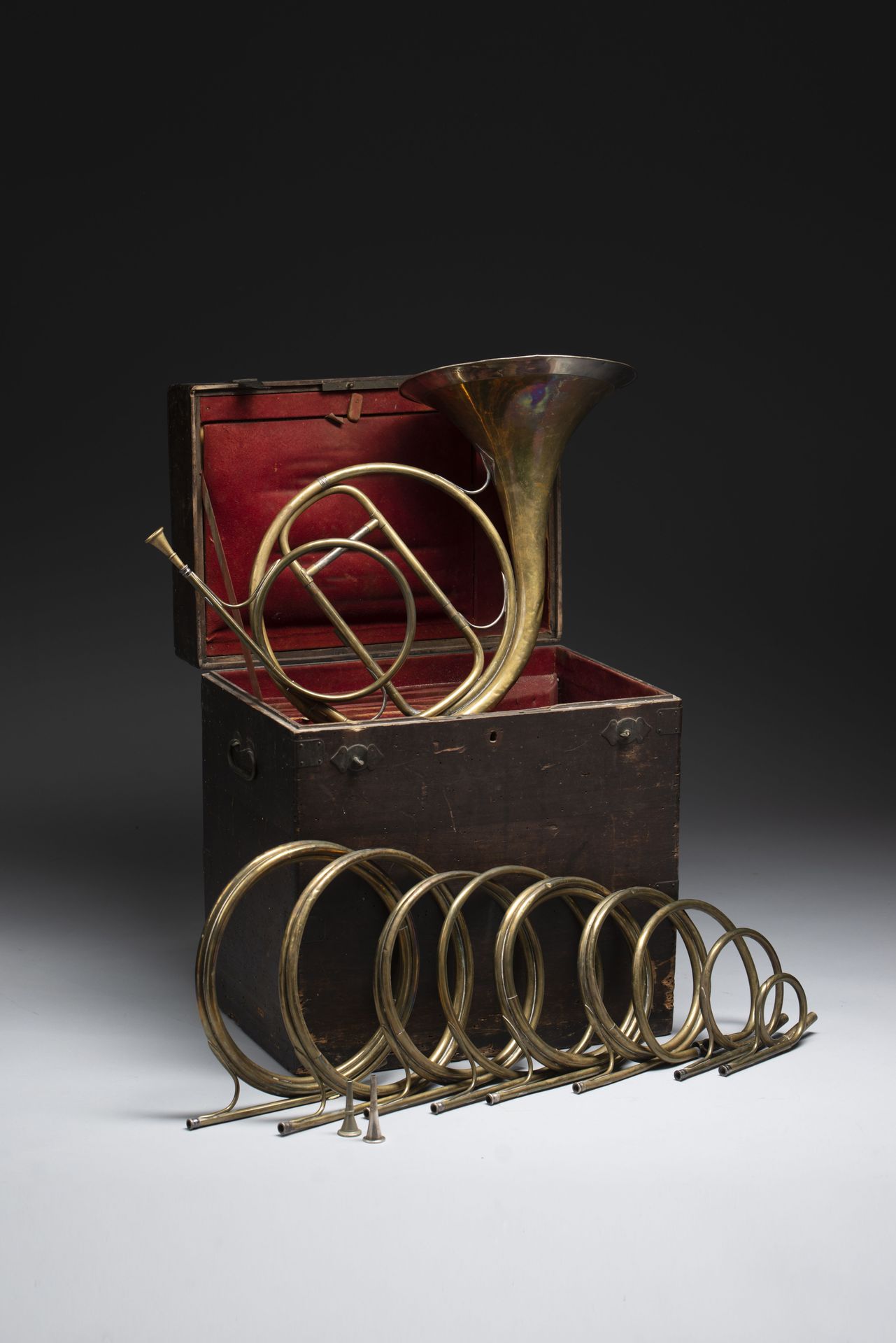Description
Marcel Auguste dit Auguste RAOUX (active from 1812 to 1857). Natural horn with interchangeable tones, the bell signed " Raoux breveté seul fournisseur du roi rue Serpente à Paris " (1814-1852). In addition, there are ten interchangeable tones and three mouthpieces. The case is covered with felt. Dimensions of the case : Height. 50 - Length : 47 - Depth : 34 cm Dimensions of the horn : Height. 34 - Diameter : 28 cm (shocks) Existing since the High Antiquity, the horn is one of the oldest musical instruments. The natural horn, invented at the beginning of the 18th century, is the evolution of the hunting horn. Used for parlor music, this horn has the particularity of not having a piston, which implies that the length of the tube, and consequently its tone, remain unchanged. The natural horn with alternate tones allows the pitch to be varied by adding its ten tubes of different sizes between the mouthpiece and the bell. The Atelier Raoux has considerably marked the history of wind instrument making in France from the 17th to the 19th century. It built a solid reputation in Paris like the great makers of Pierre-Louis Gautrot or Adolphe Sax. Its longevity, the result of a family transmission over five generations, reached its peak during the last two. Lucien Joseph Raoux (1752-1823) refined the making of natural horns, which led to a growing desire for these instruments, particularly among the most prominent horn players of the time. As for Auguste Raoux (1795-1871), the last descendant of this dynasty, he obtained in 1814 the patent of "Maker of instruments for the King and the royal theaters", then the title of "Supplier of the Emperor" in 1852. The signature on our horn "Raoux breveté seul fournisseur du roi rue Serpente à Paris", allows us to situate its manufacture between these two dates. The museum of music of the Philarmonie de Paris presents in its collections several examples of horn of the house Raoux.
91
Marcel Auguste dit Auguste RAOUX (active from 1812 to 1857). Natural horn with interchangeable tones, the bell signed " Raoux breveté seul fournisseur du roi rue Serpente à Paris " (1814-1852). In addition, there are ten interchangeable tones and three mouthpieces. The case is covered with felt. Dimensions of the case : Height. 50 - Length : 47 - Depth : 34 cm Dimensions of the horn : Height. 34 - Diameter : 28 cm (shocks) Existing since the High Antiquity, the horn is one of the oldest musical instruments. The natural horn, invented at the beginning of the 18th century, is the evolution of the hunting horn. Used for parlor music, this horn has the particularity of not having a piston, which implies that the length of the tube, and consequently its tone, remain unchanged. The natural horn with alternate tones allows the pitch to be varied by adding its ten tubes of different sizes between the mouthpiece and the bell. The Atelier Raoux has considerably marked the history of wind instrument making in France from the 17th to the 19th century. It built a solid reputation in Paris like the great makers of Pierre-Louis Gautrot or Adolphe Sax. Its longevity, the result of a family transmission over five generations, reached its peak during the last two. Lucien Joseph Raoux (1752-1823) refined the making of natural horns, which led to a growing desire for these instruments, particularly among the most prominent horn players of the time. As for Auguste Raoux (1795-1871), the last descendant of this dynasty, he obtained in 1814 the patent of "Maker of instruments for the King and the royal theaters", then the title of "Supplier of the Emperor" in 1852. The signature on our horn "Raoux breveté seul fournisseur du roi rue Serpente à Paris", allows us to situate its manufacture between these two dates. The museum of music of the Philarmonie de Paris presents in its collections several examples of horn of the house Raoux.
